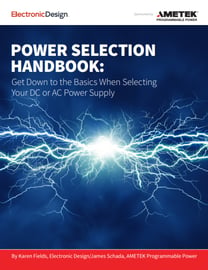Choosing the right power supply for your test system or application is no small task. Defining the power requirements for your application comes first, but this is only the beginning. Once you know the voltages and currents, you need to figure out how to power and control your source. There are several decisions that will need to be made.
That’s why AMETEK Programmable Power has released the Power Selection Handbook. Created in conjunction with Electronic Design, this 10-page guide walks you through four key questions to think about before you issue that purchase order.
What do you want out of your power supply?
The first thing that you must do when specifying a power supply is determining what outputs you need. Do you need DC outputs, AC outputs, or some combination of the two? Next, you must determine the output voltages, output currents, and output power. Then, for the DC outputs, you'll have to consider key parameters, such as output power, line regulation, load regulation, and transient response.
What are you going to feed the power supply?
Once you’ve determined what you want out of a power supply, the next question to ask is “how are you going to feed it?” For most power supplies over 1,500 W or 1,500 VA, you can’t simply plug the supply into a 120 VAC wall socket. At the very least, you’ll have to supply 220 VAC single-phase power – and if you have very high-power requirements, then you’ll need some form of three-phase power.
Where are you going to put the power supply?
Once you've determined how you're going to feed the power supply, you need to decide where you're going to put it. Environmental specifications will provide operating temperature, storage temperature, altitude, relative humidity, vibration, shock, and transportation integrity. Mechanical specifications will contain dimension, weight, chassis material and finish, installation details, cooling requirements, and output noise details. Finding the right location is crucial.
How are you going to control the power supply?
There are many ways to control a power supply: manually, analog or computer controlled.
AMETEK’s Power Selection Handbook will guide you through these and other important questions to make sure you find the right power source for your application. To view the Handbook, click here.

